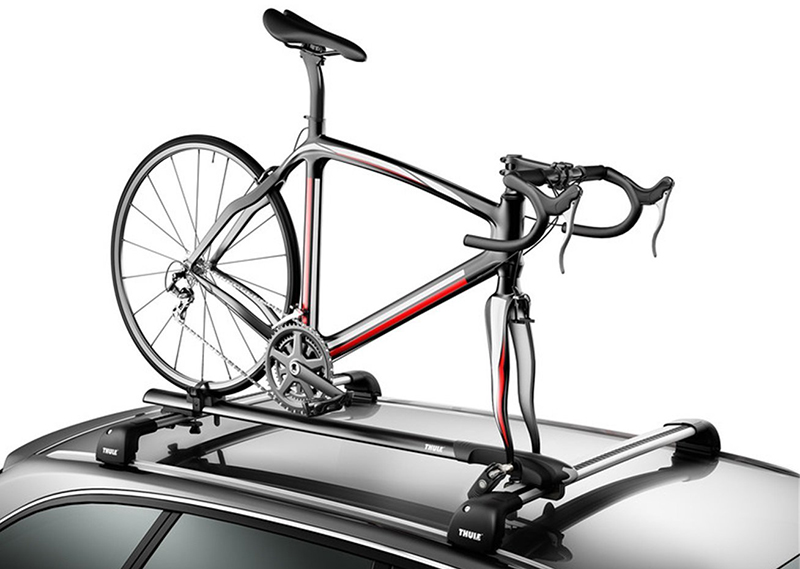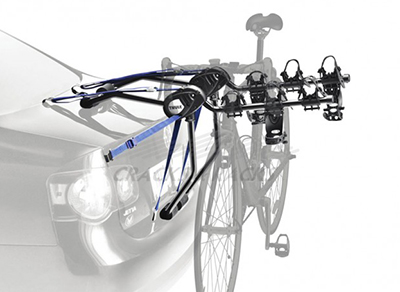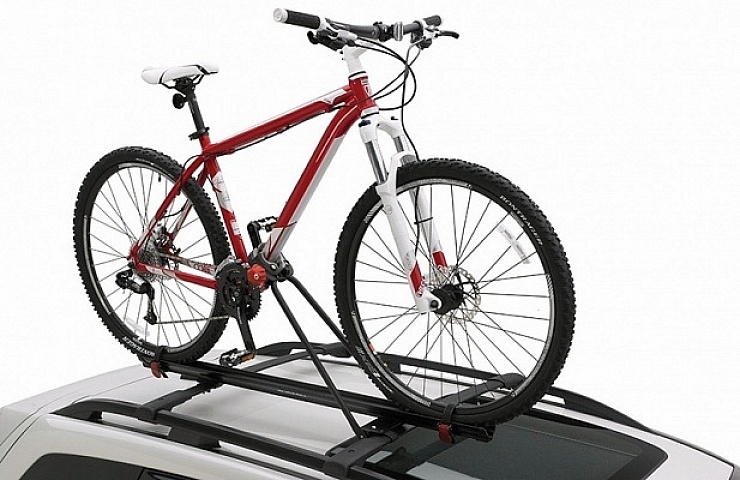Whether you’re a serious cyclist or a casual weekend bicyclist, it’s very useful to have a rack for transporting your bicycle to a favorite biking location—or take along for extended road trips. The type of rack you choose depends on the following:
- How many bicycles you are carrying
- The type of bicycles—road bikes, mountain bikes, hybrids, or cruisers without top tubes
- The type of vehicle you have and its roof height
If you’ve invested in a nice bicycle, you will want a high-quality rack to protect it during car travel. The rack needs to be strong and durable enough to keep your bicycle(s) secured on rough roads—and in the event that you need to make an evasive maneuver with your car. Yakima and Thule are two brands that make quality racks that can provide years of service.
Roof Racks

Thule fork-mount roof rack
Roof racks have the advantage of keeping your bicycle secure and out of the way of the tailgate, so it’s possible to load and unload cargo without removing the bike. They work best on vehicles with a low roof height and for relatively light bicycles. Most roof racks require roof rails with crossbars to install. Some are designed for locking both wheels, while others lock the rear wheel and front forks in place. Fork-mounted racks are slightly more aerodynamic and therefore more stable than wheel-mounted racks. For easiest access, mount the racks as close to the outside of the vehicle as possible.

Yakima DoubleDown four-bike rack
Hitch Racks
Hitch racks require that a receiver hitch is installed on the vehicle. Hitch racks are easier to reach because they don’t require lifting the bike onto the roof, making them ideal for heavier mountain bikes. Both tray-style hitch racks and hitch racks that attach to the bicycle’s top tube can accommodate multiple bicycles. If your bicycle doesn’t have a top tube, an adapter bar can work as a substitute.
The biggest disadvantage of hitch racks is that they block access to the tailgate when loaded. Just as roof racks raise the vehicle’s overall height, hitch racks increase overall length. They are, however, more aerodynamic than roof racks, having less effect on fuel economy. Also, because the bicycles are racked behind the vehicle, they are less likely to pick up bugs and dirt along the way.

Thule Passage 911XT two-bike trunk rack
Trunk-Mounted Racks
Trunk-mounted racks are the least expensive and simplest to install. Unlike hitch or roof racks, they are easy to remove when not in use. The disadvantage is security since trunk mounted racks attach with cloth straps that are easy to cut through. As with hitch racks, trunk-mounted racks block access to the trunk or tailgate. You’ll need to remove the bicycle and rack to access the cargo area.
Specialty Racks
Specialty racks use different attachment systems to fit on vehicles with unusual configurations, such as a rear-mounted spare tire. Both Yakima and Thule make racks that attach to the vehicle’s spare tire mount, holding bicycles by the top tubes. They are relatively light and fold flat when not in use.
If you own a pickup truck and need a simple way of carrying bicycles short distances, consider a tailgate pad. Look for a version with loop tie-downs to keep multiple bicycles secured in place.





